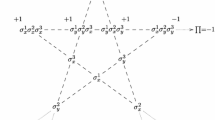Hidden variables are usually presented as potential completions of the quantum description. We describe an alternative role for these entities, as aids to calculation in quantum mechanics. This is illustrated by the computation of the time-dependence of a massless relativistic spinor field obeying Weyl’s equation from a single-valued continuum of deterministic trajectories (the “hidden variables”). This is achieved by generalizing the exact method of state construction proposed previously for spin 0 systems to a general Riemannian manifold from which the spinor construction is extracted as a special case. The trajectories form a non-covariant structure and the Lorentz covariance of the spinor field theory emerges as a kind of collective effect. The method makes manifest the spin 1/2 analogue of the quantum potential that is tacit in Weyl’s equation. This implies a novel definition of the “classical limit” of Weyl’s equation.
Similar content being viewed by others
References
Belinfante F.J. (1973). A Survey of Hidden-Variables Theories. Pergamon Press, Oxford
d’Espagnat B. (1976). Conceptual Foundations of Quantum Mechanics, 2nd edn. W. A. Benjamin, Reading MA
Holland P. (2005). Ann. Phys. (NY) 315:503
Holland P. (2005). Proc. R. Soc. A 461:3659
Bialynicki-Birula I. (1995). Acta. Phys. Pol. B 26:1201
Holland P.R. (2004). The Quantum Theory of Motion. Cambridge University Press, Cambridge
Madelung E. (1926). Z. Phys 40: 322
Holland P. (2003). Ann. Phys. (Leipzig) 12:446
Holland P. and Philippidis C. (2003). Phys. Rev. A 67:062105
Dahl J.P. (1977). Kon Danske Vid. Selsk Mat-fys. Medd 39:12
Author information
Authors and Affiliations
Corresponding author
Additional information
Article written in honour of Emilio Santos.
Rights and permissions
About this article
Cite this article
Holland, P. Hidden Variables as Computational Tools: The Construction of a Relativistic Spinor Field. Found Phys 36, 369–384 (2006). https://doi.org/10.1007/s10701-005-9022-z
Received:
Published:
Issue Date:
DOI: https://doi.org/10.1007/s10701-005-9022-z
Keywords
- hidden variables
- spinor
- quantum hydrodynamic trajectories
- Weyl’s equation
- Riemannian geometry
- classical limit
- Lorentz covariance



